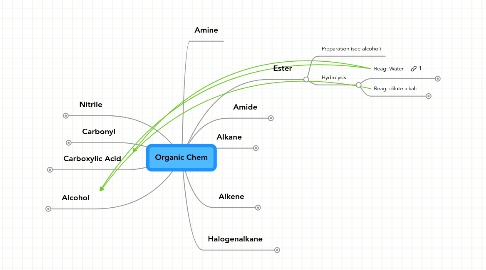
1. Alcohol
1.1. Preperation
1.1.1. Fermentation
1.1.1.1. Reag: glucose
1.1.1.2. Cond: yeast cat.
1.1.1.3. By-product: CO2
1.1.2. Hydration of ethane (see alkene)
1.2. Combustion
1.2.1. CO2+ H2O
1.3. Alkali metal
1.3.1. Giving metal alcoxide
1.3.2. Hydrogen gas produced
1.4. Oxidation
1.4.1. Primary -> aldehyde -> carboxylic acid
1.4.2. Secondary -> ketone
1.4.3. Tertiary -> nothing
1.5. Halogenation
1.5.1. Reag: conc halide acidified
1.5.2. Cond: heat
1.6. Dehydration
1.6.1. Reag: must be dry
1.6.2. Cond: heat under reflux, conc H2SO4 cat.
1.7. Esterification
1.7.1. Reag: Carboxylic acid
1.7.2. Cond: heat under reflux, conc H2SO4 cat.
2. Carboxylic Acid
2.1. Preparation
2.1.1. See nitrile acidic hydrolysis
2.1.2. See alcohol oxidation
2.1.3. See aldehyde oxidation
2.2. Making acyl chloride
2.2.1. Reag: PCl5
2.2.2. Product: acyl chloride, POCl3, HCl(g)
2.2.3. Reag: PCl3
2.2.4. Product: acyl chloride, H3PO3
3. Carbonyl
3.1. Formation
3.1.1. Aldehyde: Partial oxidation of primary alcohol
3.1.2. Ketone: oxidation of secondary alcohol
3.2. Reduction
3.2.1. Reag: NaBH4 + alcohol
3.2.2. Cond: heat under reflux
3.3. Oxidation (aldehyde)
3.3.1. Reag: Cr2O7(2-) / H(+)
3.3.2. Cond: warm gently
3.4. Nucleophilic addition
3.4.1. Reagent: CN- with sulphuric acid
3.4.2. Product: C=O -> C-OH and C-CN
3.5. Tests
3.5.1. Tollen's
3.5.1.1. Reag: Tollen's
3.5.1.1.1. Silver nitrate + sodium hydroxide -> silver oxide
3.5.1.1.2. Silver oxide + ammonia solution -> [Ag(NH3)2]+
3.5.1.2. Aldehyde reduces to silver metal
3.5.1.3. Aldehyde + OH- oxides to RCOO-
3.5.1.4. Ketone = nothing
3.5.2. Fehling's
3.5.2.1. Reag: Copper ions in solution
3.5.2.2. Aldehyde reduces to Cu2O- red ppt
3.5.2.3. Aldehyde in alkali oxides to RCOO-
3.5.2.4. Ketones = nothing
3.5.3. Brady's
3.5.3.1. Reag: 2,4-DNPH in methanol and sulphuric acid
3.5.3.2. Positive for aldehyde or ketone if bright orange/yellow ppt
3.5.3.3. H2O is produced, O from C=O is eliminated
4. Nitrile
4.1. Hydrolysis
4.1.1. Reag: dilute HCL
4.1.1.1. Cond: heat under reflux
4.1.1.2. Product: Carboxylic acid + ammonium chloride
4.1.2. Reag: sodium hydroxide
4.1.2.1. Cond: heat under reflux
4.1.2.2. Sodium salt + ammonia
4.2. Reduction
4.2.1. Reag: Hydrogen
4.2.2. Cond: Metal catalyst (Pt)
4.2.3. Product= primary amine
5. Alkene
5.1. Cis-trans Isomerism
5.1.1. Due to inability to rotate around C=C
5.1.2. Cis- same side, trans- different sides
5.2. Electrophilic Addition
5.2.1. Hydrogenation
5.2.1.1. Reag: hydrogen
5.2.1.2. Cond: high temp. Ni cat.
5.2.2. Hydrolysis
5.2.2.1. Reag: steam
5.2.2.2. Cond: high temp, pressure, acidic cat.
5.2.3. Halogenation
5.2.3.1. Reag: halogen
5.3. Oxidation
5.3.1. Cold dilute acidified manganate
5.3.1.1. Alkene-> diol
5.3.2. Hot conc acidified manganate
5.3.2.1. C=C becomes C=O
5.3.2.2. Further oxidation:
5.3.2.2.1. 2 carbonyl group -> ketone
5.3.2.2.2. 1 carbonyl group -> carboxylic acid
5.3.2.2.3. No carbonyl group- -> Carbon dioxide + water
6. Halogenalkane
6.1. Hydrolysis
6.1.1. Reag: hydroxide
6.1.2. Cond: Acidic cat.
6.1.3. Products: Alcohol + halide
6.2. Cyanide
6.2.1. Halogenalkane + cyanide -> Nitrile + halide
6.2.2. Heat under reflux
6.3. Ammonia
6.3.1. Halogenalkane + ammonia -> amine + hydrogen halide
6.4. Elimination
6.4.1. Cond: Heat under reflux
6.4.2. Reag: conc sodium/potassium hydroxide in ethanol
6.4.3. Product: Alkene, metal halide, H2O
6.5. Nucleophilic substitution
6.5.1. Primary- Sn2. Conc of both reag.
6.5.2. Tertiary- Sn1. Conc of only halogenalkane
7. Alkane
7.1. Combustion
7.1.1. Gives carbon dioxide and water only
7.2. Halogenation
7.2.1. Free radical substition
7.2.2. Condition: UV light
7.2.3. 3 stages
7.2.3.1. Initiation
7.2.3.2. Propagation
7.2.3.3. Termination
7.3. Fractional Distillation
7.3.1. Crude oil
7.3.2. Gives
7.3.2.1. Refinery gases
7.3.2.2. Gasoline
7.3.2.3. Naphtha
7.3.2.4. Kerosene
7.3.2.5. Diesel oil
7.3.2.6. Fuel oil
7.3.2.7. Bitumen
7.4. Cracking
7.4.1. Long chain hydrocarbon-> shorter, more useful
7.4.2. Conditions: Heat + pressure/catalyst
8. Ester
8.1. Preparation (see alcohol)
8.2. Hydrolysis
8.2.1. Reag: Water
8.2.1.1. Cond: heat under reflux, dilute acid cat.
8.2.1.2. Product: carboxylic acid + alcohol
8.2.2. Reag: dilute alkali
8.2.2.1. Cond: heat under reflux
8.2.2.2. Product: sodium salt + alcohol
9. Amine
10. Amide
10.1. Hydrolysis
10.1.1. Reag: dilute acid e.g. HCl
10.1.1.1. Cond: heat
10.1.1.2. Product: carboxylic acid + ammonium chloride
10.1.2. Reag: alkaline
10.1.2.1. Cond: heat
10.1.2.2. alkali salt + ammonia
